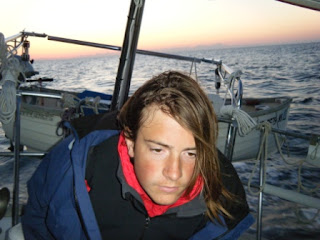 |
| Chart view of course from Cape Lookout to Masonboro Inlet. Note slight bend in center where we skirted the Restricted Area off Camp Lejeune. [courtesy Capt Pat O] |
 |
| Cape Lookout Lighthouse from the Bight |
 |
| Sunset over Power Squadron Spit, Cape Lookout |
We motored the ICW out Beaufort Inlet to Cape Lookout Bight, a beautiful and open anchorage protected from the ocean swells by the cape, where we anchored, ate dinner and waited for the promised NE wind. A loggerhead turtle raised its head above water as if inspecting our arrival; it looked like a human out for an evening swim. As the wind had been SW all day, we were confused that there was no northerly element to it until we realized that the SW sea breeze was overcoming the lighter NE. About 2000, the SW retired and the NE began to build.
We set sail just before 2100, dodging an anchored freighter and charting a new routine on the radar/chartplotter, our eyes on what began as a moonless night. The NE wind was fresh, the seas mildly lumpy, and Cameron and I drew the 0200-0600 watch. We climbed into our berths for a rolly sleep. Lying against the hull, I rested to the tunes of water rushing past with the occasional slap of an errant wave. I could tell by the sounds that we were making good speed.
 |
| Capt Pat at chartplotter early night at sea. |
Although I really did not fall into a deep slumber, Cameron did, so he was refreshed to stand watch when we woke just before 0200. Half of the moon was high and bright over the sea when we came topside; Pat and Judy had earlier watched it rise orange from the edge of the world. Thalia was making 5 knots on a beam reach, which we maintained until altering course a couple of hours later (per Capt Pat's route plan) which yielded closer to 6 knots as we edged closer to the wind. With nighttime temps in the low 50s and a good breeze off the beam, it was chilly. During our watch, I sucked down a couple of cups of coffee and ate an energy bar to keep the calories burning. Cameron just toughed it out. About 0315, we heard the call of several loons off our starboard stern.
 |
| Sunrise at sea. Cameron on watch (checking radar). |
Dawn came early. It was only 0500 when the horizon brightened. Pat had requested to be awakened no later than 0600 (even if we were feeling energetic enough to extend our watch) so he could see the sun rise. He woke in time. We had seen only two distant radar returns, maybe a trawler and a fishing boat, during our watch. Otherwise, just a cold, dark empty sea.
Thalia sailing in Atlantic Ocean click to view video
Thalia sailing in Atlantic Ocean click to view video
Masonboro Inlet is well-defined and well-protected by two large rock jetties. After dodging some small fishing boats that were too absorbed with their fishing lines to watch where they were heading, we doused the sails and headed for Sea Path Marina.
With temps in the high 40s, I slept the sleep of the dead before waking at 0700 for our departure. The winds were forecast to begin out of the east (which is how they were blowing) but were supposed to clock around to the SE, the wind bearing we needed to sail back north. We cast off for our return to Cape Lookout. We expected that we would not arrive at the Cape until after dark, but we were familiar with the entry channel, had fair weather and plenty of recorded waypoints in the chartplotter.
Once clear of the inlet, we set the sails and pushed as close to the wind as we could. Unfortunately, close-hauled still caused us to sail toward the easterly bend in the coastline. We had to motor back to sea, with a prayer that the SE winds would emerge sooner rather than later. Short story, we never saw anything other than east winds. Nevertheless, our search for favorable winds took us farther offshore into deeper blue waters. We watched the antic, frantic, flight of flying fish, their small silver bodies leaping from the sea and scooting over the waves for tens of (maybe a hundred?) yards at a time. Dolphins played, turning back flips. Several fishing boats floated in the distance. Strangely, the fishfinder showed not a single fish under us during our entire day. [Later, at night, there was a bloody fish convention as we approached Beaufort and Cape Lookout.]
 |
| True blue. 90 ft deep, 15 miles out. |
 |
| Sunset at sea |
Once again, the ocean gave us fair swells and small waves as we headed for a night anchoring back in Cape Lookout Bight. No land in sight. The radar returned targets for far-off ships and two freighters in the mooring field off Beaufort Inlet. And the radar also lit up the buoys marking the long entrance channel into the inlet.
It was absolute dark when we turned into the channel for the Bight. Despite land lights behind Shackleford Banks, we could see nothing, just a deep, dark void where we knew there was land. The lighthouse swung its beam in a slow, steady pulse as we eased toward the center of the basin. By midnight, we were secure at anchor. A cool breeze blew over the quiet water.
Cameron and I really appreciate Pat and Judy inviting us along. Cameron's debut overnight in the ocean was something he really enjoyed, and I know he will remember it forever. For all good reasons.
No comments:
Post a Comment
Note: Only a member of this blog may post a comment.